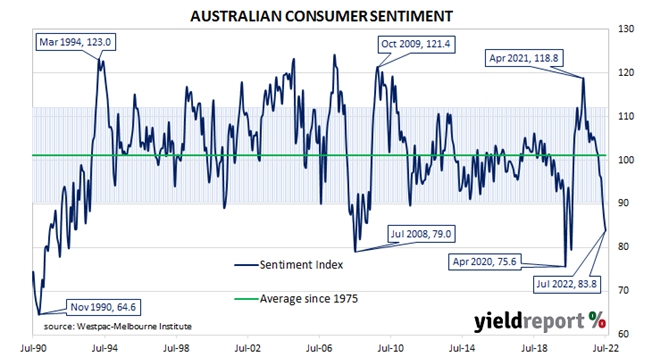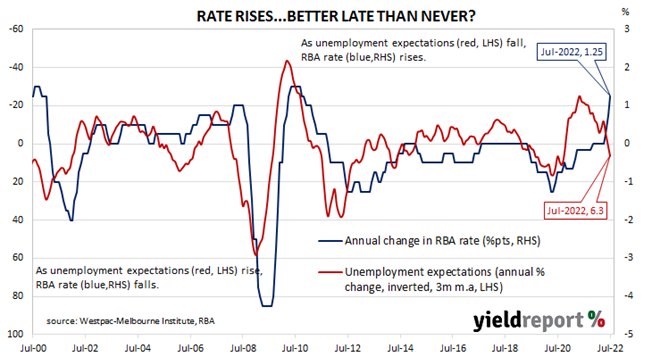Summary: Household sentiment deteriorates for eighth consecutive month in July; “anxiety” around interest rates increasing; four of five sub-indices lower; respondents more concerned by prospects of unemployment.
After a lengthy divergence between measures of consumer sentiment and business confidence in Australia which began in 2014, confidence readings of the two sectors converged again in mid-July 2018. Both measures then deteriorated gradually in trend terms, with consumer confidence leading the way. Household sentiment fell off a cliff in April 2020 but, after a few months of to-ing and fro-ing, it then staged a full recovery. However, consumer sentiment has deteriorated significantly over the past year, while business sentiment has been somewhat more robust.
According to the latest Westpac-Melbourne Institute survey conducted in the first week of July, household sentiment has deteriorated for an eighth consecutive month. Their Consumer Sentiment Index fell from June’s reading of 86.4 to 83.8, a reading which is below the range of “normal” readings and significantly lower than the long-term average reading of just over 101.
“Without doubt consumers are still very sensitive to the inflation pressures on their budgets but it appears their anxiety around interest rates is increasing,” said Westpac Chief Economist Bill Evans.
Any reading of the Consumer Sentiment Index below 100 indicates the number of consumers who are pessimistic is greater than the number of consumers who are optimistic.
Commonwealth Government bond yields moved higher on the day. By the close of business, the 3-year ACGB yield had gained 5bps to 3.16%, the 10-year yield had added 2bps to 3.53% while the 20-year yield finished 5bps higher at 3.77%.
In the cash futures market, expectations of higher rates eased. At the end of the day, contracts implied the cash rate would rise from the current rate of 1.31% to 1.73% in August and then increase to 2.785% by November. May contracts implied a 3.485% cash rate and August 2023 contracts implied 3.435%.
Four of the five sub-indices registered lower readings, with the “Economic conditions – next 5 years” sub-index posting the largest monthly percentage loss. The reading of the “Family finances – next 12 months” sub-index was the only one to increase and, even then, its rise was negligible.
The Unemployment Expectations index, formerly a useful guide to RBA rate changes, increased from 108.5 to 109.6. Higher readings result from more respondents expecting a higher unemployment rate in the year ahead.



